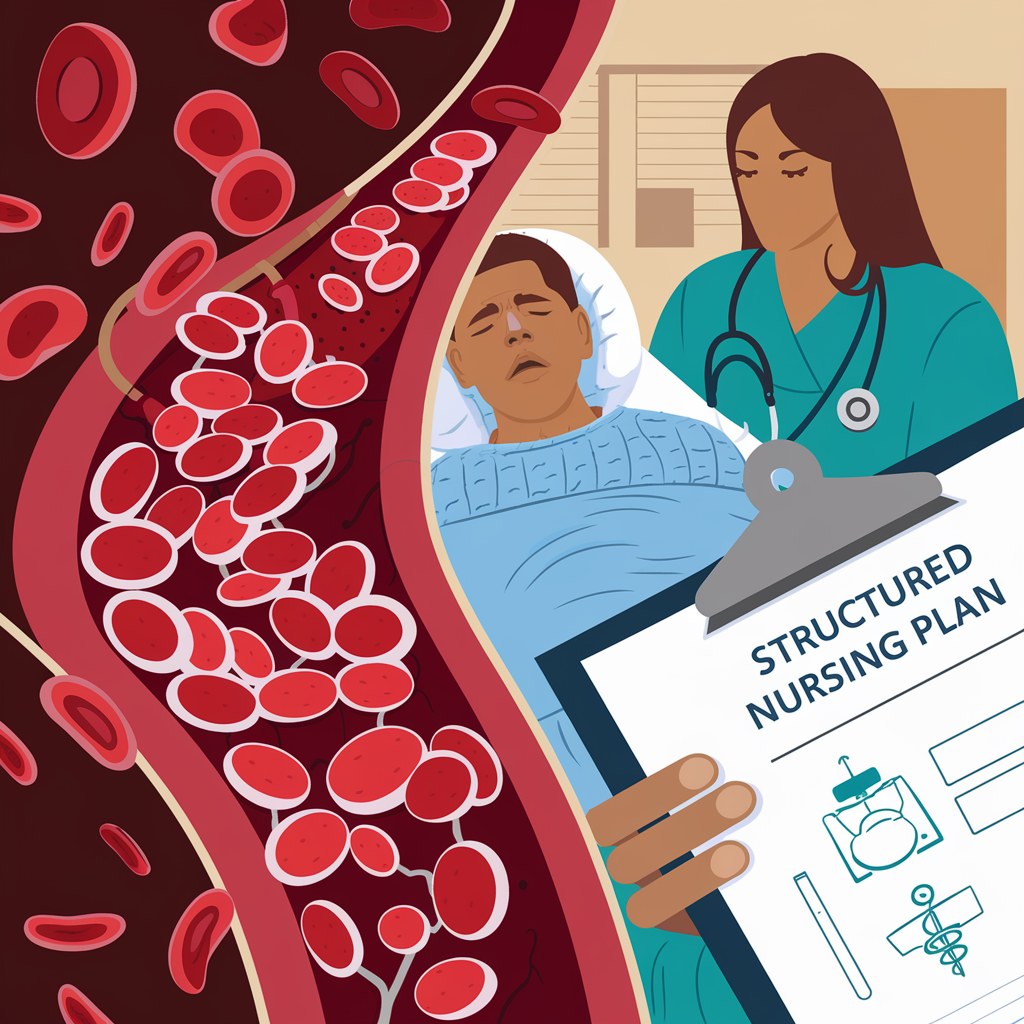Sickle Cell Anemia NCP: Imagine if your red blood cells, instead of being soft and round like tiny donuts, turned into hard, crescent-shaped cells. These misshapen cells wouldn’t flow smoothly in your bloodstream. Instead, they’d get stuck in small blood vessels, blocking oxygen from reaching different parts of your body. This is what happens in sickle cell anemia.
Thank you for reading this post, don't forget to subscribe!
Now, let’s talk nursing! If you’re a nursing student, you already know that every disease needs a structured plan for care. That’s where a Nursing Care Plan (NCP) comes in! An NCP for sickle cell anemia ensures that nurses provide consistent, effective care, helping patients manage pain, prevent complications, and live healthier lives.
In this detailed guide, you’ll learn everything about Sickle Cell Anemia NCP, from patient assessment to nursing interventions and expected outcomes. Whether you’re writing an assignment or preparing for clinical practice, this article will be your best friend. So, grab your notebooks (or just bookmark this page), and let’s dive in! 🚀


What is Sickle Cell Anemia?
Before we jump into the Nursing Care Plan for Sickle Cell Anemia, let’s quickly understand the basics.
Definition
Sickle Cell Anemia (SCA) is a genetic blood disorder in which red blood cells (RBCs) become rigid and sickle-shaped, leading to blockages in blood vessels, reduced oxygen transport, and severe pain episodes.
Causes of Sickle Cell Anemia
SCA occurs due to a mutation in the HBB gene, which is responsible for making hemoglobin (Hb). Instead of normal Hemoglobin A (HbA), patients with sickle cell disease produce Hemoglobin S (HbS), which causes red blood cells to change shape.
Risk Factors
- Genetic Inheritance: SCA is an autosomal recessive disorder, meaning a person must inherit the mutated gene from both parents to develop the disease.
- Ethnicity: More common in African, Indian, Mediterranean, and Middle Eastern populations.
- Family History: If both parents are carriers (sickle cell trait), their child has a 25% chance of developing the disease.
Common Complications of Sickle Cell Anemia
- Vaso-occlusive Crisis (VOC): Severe pain due to blocked blood flow.
- Stroke: Sickled RBCs can block arteries in the brain.
- Anemia: Decreased red blood cell count leads to fatigue and weakness.
- Infections: SCA patients have a weakened immune system.
- Organ Damage: Long-term complications can affect the heart, kidneys, and liver.

Patient Information (Example Case Study)
Note: The following patient details are fictional and only for educational purposes.
- Name: Ravi Kumar
- Age: 16 years
- Gender: Male
- Medical History: Diagnosed with sickle cell anemia at age 5, history of frequent hospitalizations due to pain crises, jaundice, and anemia.
- Symptoms: Severe joint pain, fatigue, shortness of breath, pale skin, delayed growth, swollen hands and feet, yellowish eyes (jaundice).
- Medical Diagnosis: Sickle Cell Anemia Crisis
- Admission Date: 12th January 2025
- Care Plan Initiated: 13th January 2025
Comprehensive Nursing Care Plan for Sickle Cell Anemia
1. Nursing Assessment
| Assessment Type | Details |
|---|---|
| Subjective Data | Patient reports severe body pain (8/10 on pain scale), dizziness, and difficulty concentrating. He feels extremely tired and complains of headaches. |
| Objective Data | – Vital Signs: Temperature: 100.4°F, Heart Rate: 110 bpm, Respiratory Rate: 24 bpm, BP: 98/60 mmHg |
- Hydration Status: Dry lips, reduced urine output
- Pain Assessment: Intense pain in joints, chest, and abdomen
- Skin Examination: Pale, jaundiced eyes, delayed wound healing
- Laboratory Values: Low hemoglobin (7.5 g/dL), increased WBC count, abnormal blood smear showing sickle-shaped RBCs |
2. Nursing Diagnoses
- Acute Pain related to vaso-occlusive crisis as evidenced by patient’s verbal reports of severe joint pain.
- Ineffective Tissue Perfusion related to sickled red blood cells blocking blood flow.
- Risk for Infection related to compromised immune function.
- Fatigue related to decreased oxygenation due to anemia.
- Deficient Knowledge regarding disease management and prevention of crises.
3. Nursing Interventions and Rationales
| Nursing Intervention | Rationale |
|---|---|
| Administer prescribed pain medications (e.g., NSAIDs, opioids) as needed. | Helps relieve severe pain associated with vaso-occlusive episodes. |
| Encourage increased fluid intake (at least 3L/day). | Hydration prevents sickling of RBCs and reduces the risk of vaso-occlusive crises. |
| Monitor oxygen saturation and administer oxygen therapy if needed. | Prevents hypoxia and helps maintain proper oxygen levels in the blood. |
| Apply warm compresses to painful areas. | Promotes blood flow and reduces muscle stiffness. |
| Educate the patient and family about triggers of sickle cell crises (e.g., dehydration, infections, extreme temperatures). | Helps prevent future complications and promotes self-care. |
4. Nursing Goals
- Reduce pain levels to a manageable degree (below 3/10 on the pain scale).
- Improve oxygenation by maintaining SpO₂ above 95%.
- Prevent infections by ensuring proper hygiene and vaccination.
- Enhance patient knowledge about sickle cell anemia and self-care.
- Promote proper hydration to prevent further complications.
5. Evaluation and Expected Outcomes
| Expected Outcome | Evaluation Criteria |
|---|---|
| Patient reports less pain | Pain scale reduced from 8/10 to 2/10 within 48 hours. |
| Oxygen levels remain stable | SpO₂ maintained above 95% with no signs of respiratory distress. |
| No new infections occur | No fever or other signs of infection during hospital stay. |
| Patient understands self-care | Patient and family correctly describe sickle cell triggers and preventive measures. |
| Hydration is maintained | Urine output and skin turgor improve within 24 hours. |
Frequently Asked Questions (FAQs)
1. What is a sickle cell anemia NCP?
A Sickle Cell Anemia Nursing Care Plan (NCP) is a structured guide that helps nurses provide effective care to patients with sickle cell disease. It includes assessment, diagnosis, interventions, and expected outcomes.
2. How do nurses manage pain in sickle cell anemia?
Nurses use pain medications, warm compresses, hydration, and oxygen therapy to relieve pain during a sickle cell crisis.
3. Why is hydration important for sickle cell patients?
Hydration prevents red blood cells from sickling and reduces the risk of painful vaso-occlusive crises.
4. What are the main triggers of a sickle cell crisis?
Common triggers include dehydration, infections, extreme cold or heat, stress, and high altitudes.
5. Can sickle cell anemia be cured?
Currently, the only potential cure is a bone marrow transplant, but it is not always an option. Most treatments focus on managing symptoms.
Recommended Resources
- Sickle Cell Anemia – WHO Guidelines
- Nursing Care Plan Templates
- Sickle Cell Disease Foundation
- Latest Research on Sickle Cell Treatment
🚑💉 Hope this guide helps you ace your Sickle Cell Anemia NCP assignment!


